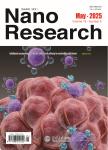版权所有:内蒙古大学图书馆 技术提供:维普资讯• 智图
内蒙古自治区呼和浩特市赛罕区大学西街235号 邮编: 010021

作者机构:College of Marine Life ScienceOcean University of ChinaQingdao 266003China CAS Key Laboratory for Biomedical Effects of Nanomaterials&NanosafetyCAS Center for Excellence in NanoscienceNational Center for Nanoscience and TechnologyBeijing 100190China Laboratory for Marine Drugs and BioproductsPilot National Laboratory for Marine Science and Technology(Qingdao)Qingdao 266235China University of Chinese Academy of SciencesBeijing 100049China
出 版 物:《Nano Research》 (纳米研究(英文版))
年 卷 期:2023年第16卷第12期
页 面:13164-13181页
核心收录:
学科分类:1002[医学-临床医学] 1001[医学-基础医学(可授医学、理学学位)] 100102[医学-免疫学] 100214[医学-肿瘤学] 10[医学]
基 金:supported by grants from the National Key R&D Program of China(Nos.2021YFA1201100,and 2022YFA1206100) the National Natural Science Foundation of China(Nos.32271449,32201158,and 51773188) CAS Project for Young Scientists in Basic Research(No.YSBR-036) Key Project of Natural Science Foundation of Shandong Province(No.ZR2020KE016) Shandong Provincial Key Research and Development Program(Major Scientific and Technological Innovation Project,No.2022CXGC010505)
主 题:metalloimmunology metal metabolism cancer immunotherapy nano-enabled delivery system cGAS-STING pathway ferroptosis and cuprotosis
摘 要:Metals are essential components of both micronutrients and macronutrients in living organisms and are involved in a variety of immune processes in the forms of free ions or protein-coupled complexes(metalloproteins).Multiple aspects of the immune system,from the structural and functional control of immune-related proteins to the cellular responses to immunotherapy,could be affected by ***,the employment of metal for the regulation of immunity,termed as metalloimmunology,is gaining interest as a prevalent and efficacious approach to combating ***,the manipulation of metalloimmunology using traditional drugs presents several challenges,including limited bioavailability,adverse effects,and a lack of targeting *** review provides an overview of the latest findings in metal and metal-regulatory therapeutic agents for the treatment of *** trace metal elements,such as iron,zinc,copper,manganese,magnesium,and calcium,as well as heavy metal drugs and their mechanisms of action,will be discussed with a particular focus on their roles in regulating the tumor-immune *** latest nanotechnology employed in the administration of metal-regulatory drugs and the design concepts for tailored therapeutic interventions will be *** concepts and information offer promising clinical possibilities of modulating cancer immunology by targeting metal metabolism.